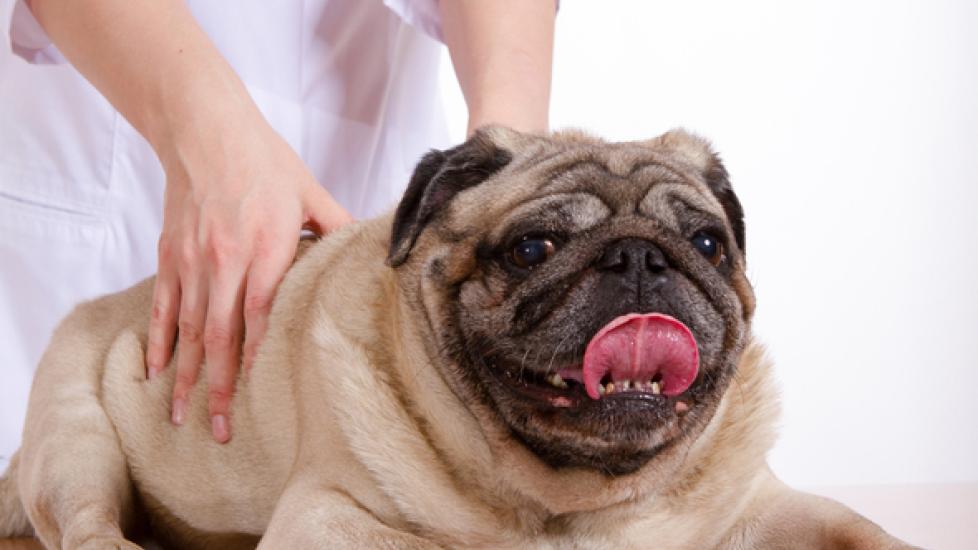When to See a Dog Chiropractor and What They Can Do
Image via Sergey Gerashchenko/Shutterstock.com
By Heather Larson
Dogs often benefit from alternative therapies like massage, homeopathy, calming flower essences like the popular Rescue Remedy drops, acupuncture and chiropractic. All of these fall under the umbrella of complementary and alternative medicine (CAM).
More and more pet parents and veterinarians are recognizing the value of these and other holistic treatments. One CAM practice that has recently become more popular is chiropractic for dogs.
Canine chiropractors can help dogs with mobility issues, but as Dr. Katie Malensek, DC, DVM, of Ravenwood Veterinary Clinic in Port Orange, Florida, explains, if your dog looks like he’s having a hard time getting up or moving around, your first step should be an assessment by your veterinarian.
“Even though a vet referral to a chiropractor isn’t required in all states, your veterinarian should be the one who tells you when it’s time for a dog chiropractor,” says Dr. Malensek. They can guide you to someone with the proper credentials and knowledge.
Credentials to Look for in a Dog Chiropractor
When medical professionals want to add chiropractic for dogs to their resumé, they must either have a veterinarian degree (DVM) or a human chiropractor degree (DC).
To become a certified dog chiropractor, they must undergo training in the subset of animal chiropractic. The specifics for training and certification vary state by state, says Dr. Jessica Paige, CCSP, an animal and human chiropractor in San Jose, California. The norm for additional training in animal chiropractic is 210 hours of study at a program approved by the Animal Chiropractic Certification Commission (ACCC).
With this specialization, animal chiropractors can help mitigate a variety of issues in dogs, cats and horses. They handle musculoskeletal ailments, like a limp that won’t go away, and intervertebral disc disease (IVDD) in animals’ backs. Dog chiropractors might also treat hip dysplasia, osteoarthritis and stiffness, and help with surgery recovery.
“We also treat animal athletes, including dogs that compete in agility and flyball,” says Dr. Paige. “Service dogs that pull wheelchairs and police dogs that are trained to bite often have neck problems, so we work with them, too.”
If you’ve received a referral to a canine chiropractor from a licensed veterinarian, you should have nothing to worry about.
Should you have to locate your own dog chiropractor, go to the website for the American Veterinary Chiropractic Association (AVCA) or the International Veterinary Chiropractic Association (IVCA), and search by your location.
“A good chiropractor should be in one of those associations, which means he or she has done postgraduate schooling and passed rigorous testing to achieve certification,” says Dr. Paige.
What to Expect From a Canine Chiropractor
At your first appointment, the dog chiropractor will do a thorough exam and assessment, says Dr. Malensek. He or she looks at the way the dog moves and stands, as well as its anatomy, and probes for areas of discomfort or asymmetry. If your veterinarian hasn’t already taken X-rays, that may be part of the first examination as well.
“Then I perform an adjustment, either with an activator (a chiropractic adjustment tool) or my hands,” says Dr. Malensek. “After the adjustment, the pet parent and I make a treatment plan going forward.”
Dr. Malensek recommends more than one appointment for an adjustment, but also says that when the animal becomes comfortable and has good mobility, the treatment is complete.
However, for some pet patients, ongoing adjustments are better suited for their needs. Dr. Paige cites a case of a 14-year-old dog she treats every two weeks to help him maintain a better quality of life. He moves better, likes to go on walks and is more willing to play with the other dog in the household when he’s regularly adjusted.
Another reason to see a canine chiropractor is if you have a puppy whose breed is predisposed to IVDD. Dachshunds, Corgis and Basset Hounds all fit into that category.
When evaluated as a puppy, the chiropractor gets a baseline of how they are moving. Then they can take measures so the pup is less likely to have issues in the future.
Side Effects of Chiropractic for Dogs
A dog may sleep the rest of the day after a chiropractic visit, and that’s normal, says Dr. Paige. Like humans, when a canine gets adjusted, they may feel soreness, but not for more than two days, she says. Then they’re back to normal. Dogs may also express some vocal reaction.
If chiropractic care is preformed prematurely and by those without the proper credentials, you might see more severe side effects.
“If there’s a fracture and no X-ray was taken, or diabetes wasn’t diagnosed originally, you can worsen the problem with chiropractic,” says Dr. Malensek. “But it’s generally a very safe modality.”
Because there’s some stigma around animal chiropractic, says Dr. Malensek, you should know that it’s not an exclusive modality, but is usually part of a larger picture of holistic care for dogs. Adding medicine and other types of treatment, such as massage, laser therapy, acupuncture or rehabilitation (aka water treadmills) can certainly be part of the protocol to improve your dog’s issues.
Help us make PetMD better
Was this article helpful?
